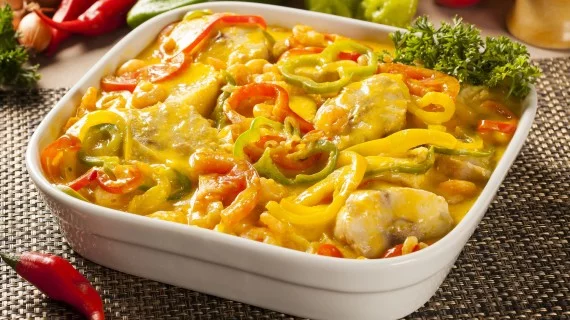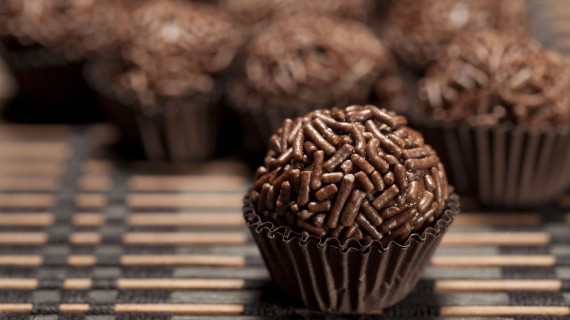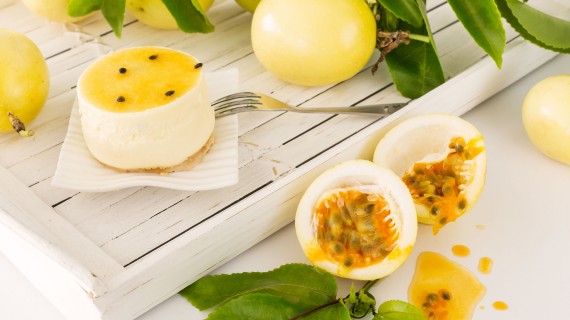The gastronomy of Brazil includes a great variety of dishes and flavors, among which three great influences can be classified: indigenous, European and African. Most of the ingredients and typical dishes of Brazil can be found today in any city that we visit in the country.
Below you have an index with all the points that we are going to deal with in this article.
Article Index
- 1.
- 1.1.
- 1.2.
- 1.3.
- 1.4.
- 1.5.
- 1.6.
- 1.7.
- 1.8.
- 1.9.
- 1.10.
- 2.
- 2.1.
- 2.2.
- 2.3.
- 3.
- 3.1.
- 3.2.
- 3.3.
- 3.4.
- 3.5.
- 3.6.
Typical dishes of Brazil
One of the most typical ingredients in traditional Brazilian dishes is beef. Fried dishes are also very frequent, as is the case of acarayé or Coxinha, two of the most popular appetizers of Brazilian origin. The use of fish and fruits such as yucca is also very frequent, as you can see in the following list of main dishes in Brazil.
Sun dried meat
This dish, also called jaba, consists in dried meat that has been previously exposed to the sun for at least four days. Since it requires a dry climate, this dish is more common in the semi-arid areas of northeast Brazil, such as Bahia, Ceará, Maranhão, Paraíba, Piauí, Pernambuco, Rio Grande do Norte, etc.
In the following video, you can see how the carne-de-sol is prepared in detail:
It is estimated that the origin of this meat preparation technique dates back to the Prehistory, specifically, the first indigenous communities from Brazil. These groups of people used this cooking method simply because they had no money to preserve food. Therefore, the process of salting and exposing the meat to the sun was the most effective.
In addition to the carne-de-sol, there are two other salted meat dishes: dried meat and jerky. Although all three dishes may look the same, the difference between them lies in how they are prepared.
Dried meat requires greater amounts of salt and more time to be exposed to the sun, while jerky is packed in vacuum plastic packaging, so it requires a more elaborate preparation process.
acarayé
In Portuguese called Shrimp bean ball, consists in thick bread rolls made from white beans and onion that have been left to rest from the night before. It is fried in palm oil and served with sauce, which can be vatapá, cream of dried shrimp or cururú of green beans. It is a very typical dish from Bahia.
The origin of this kind of bun is most likely African, specifically, the indigenous communities of Africa who emigrated to Brazil. Like the candombié, the acarayé is related to Afro-Brazilian religious traditions. It is usually taken as an aperitif at snack time.
Coxinha
This dish is rather a type of appetizer widely consumed in Brazil, as well as in Portuguese cuisine. The term drumstick literally means in Portuguese thigh, because it is prepared with chicken breast (known in the region as chicken).
Once fried, the chicken breast is wrapped in a batter, so that the breast is breaded. Finally, they are fried in abundant oil. The result is similar to the popular croquettes in the spanish tapas. They are usually eaten dipped in hot sauce.
Moqueca
Also know as Fish Moqueca, is prepared with fish, salt, spices and herbs that vary according to the area. It is usually marinated with onion, pepper, tomato, and coriander leaves, as well as coconut milk and palm oil (palm oil in Portuguese). No water is used for cooking and its preparation requires time. If you want to learn to prepare Fish Moqueca, you can do it with the following video:
Like many other traditional Brazilian dishes, moqueca is from indigenous origin. It was originally prepared with the leaves of various trees and, therefore, there are two variants today. On the one hand, we find the Moqueca Baiana, whose home state is Bahia, located in the Northeast Region of Brazil. On the other hand, we find the Moqueca Capixaba, original from Espírito Santo, to the southeast.
Furthermore, the Moqueca Capixaba It is a variety of moqueca from the state of Espírito Santo. The ingredient that differentiates this variant of moqueca is the annatto, also known as annatto (in Spanish, achiote), a reddish-yellowish spice. The fish that is usually used for its preparation is sea bass, which is cut into thick slices, washed and seasoned with salt and lemon. In addition, tomato, onion, coriander, minced garlic, oil, powdered achiote coffee and fish broth are added.
Tapioca
The call tapioca It is a popular dish in other Latin American countries, as for example in Venezuelan gastronomy. Also known as cassava cassava Or simply, casabe o cassava, is a type of crusty bread made from yucca.
For its preparation, it is grilled either on a budare or on a comal. The result is unleavened bread, crisp, fine and circular in appearance.
Its consumption is estimated that it began already in prehispanic times, because cassava was, along with corn, the main crop in the area. The tapioca or casabe was one of the main sources of food for the indigenous people.
Tucupi
Tacacá is a soup made from jambú and tucupí grass, which consists of a broth made with the manioc plant, and shrimp. It is usually served in a jar and it is a tradition not to use any cutlery, but to take it with the fingers. There are two main dishes with which this kind of soup is used: the Tacaca Not Tucupi and Duck No Tucupí.
In the first case, the main ingredient of this soup species called Tacaca Not Tucupi, traditionally served in a jar, are the prawns. The most traditional is to sip it, bringing the lips to the bowl and sipping in small quantities. This is due to the fact that to take it in a traditional way, you should not use any utensil, so when you take the shrimp you use your fingers.
With regard to the Duck No Tucupí, Its main ingredient is the Tucupí broth, which is prepared with a yellowish sauce of wild cassava, and is seasoned with an herb called jambo. It is a dish that is cooked in the oven. For its preparation, you need a large duck, onions cut into rings, garlic, bacon, tomatoes, vinegar, chopped bay leaf, cumin coffee, pepper, oil, watercress, Tucupí and toasted cassava flour.
Cheese bread
One of the specialties of the Mato Grosso cuisine are the Cheese Breads, that is, they are cheese buns made from very fine flour and minas cheese, a very popular variety of cheese in Brazil.
To prepare this traditional cheese bread in the state of Minas Gerais, you need a glass of milk, oil, water, sweet or sour cassava starch, eggs and 300-400 g of minas cheese.
Coalho cheese
El Coalho Cheese It is a typical aperitif of Brazilian food in general and of the Northeast Region of Brazil in particular. These fried cheese strips They are made with pasteurized cheese, made from fermented cow's milk. Its flavor could be classified as slightly salty and its texture is thick and soft.
The most common is to take it as an aperitif and, in fact, it is usually sold on some beaches in Brazil in street stalls. Its price is usually very cheap. The flavor of this cheese depends on the type of ingredients with which it is prepared, although the most typical are the oregano and it.
Feijoada
Considered a national dish, it is made from black beans combined with smoked or salted meats, usually pork. They are served with cassava flour, fried plantain, chopped cabbage, rice or oranges. You can also add other ingredients, such as eggs and sausages.
A curiosity about this dish is that, traditionally, it is served on Wednesdays and Saturdays, so these days you can taste the feijoada in the vast majority of restaurants in the southern region of Brazil.
Top Loin
This dish consists of roast beef, either grilled or grilled. Although it is a very common dish also in other South American countries such as Argentina or Bolivia, in Brazil the element that characterizes it is that it is usually accompanied by cassava flour and tomato sauce. It is a tradition to grill meat with swords.
In the following video you can see from beginning to end what the process of preparing a good Brazilian churrasco is like:
There is a type of churrasco called filet steak, because the part that is cooked in this case is the back of the beef tenderloin. This part of the ox is the most appreciated type of meat in the whole country. It is customary to cook it on the grill, that is, in a barbecue or barbecue.
Beverages
The flavors of typical Brazilian drinks are characterized by being the most exotic on the palate. For its preparation, fermented sugar and tropical fruits are very present. More than drinks, it would be more appropriate to talk about refreshing and sweet cocktails. Below we list the best known.
Caipirinha
Adapted to Spanish as caipirinha, this cocktail is prepared based on cachaça (cachaça in Spanish), which is obtained from the distillation of fermented sugarcane juice. The other basic ingredient in caipirinha is the lime, which is also usually cut into slices to decorate the glass.
Guarana
Guarana is a fizzy energy drink which is made with ground guarana seed. It contains caffeine and is also consumed in other countries in South America, such as Paraguay. It has been marketed under the brands Brahma y Antarctica.
Coconut milkshake
The coconut shake is a very easy drink to make whose main ingredient is coconut and milk, ingredients to which sugar (usually brown sugar) is added and everything is crushed. Finally, it is usually served with sprinkled cinnamon.
Desserts
Coconut, chocolate, condensed milk, passion fruit, milk ... possibly these are the most used ingredients for the preparation of traditional Brazilian desserts. This, once again, gives a touch of the most exotic to these sweet dishes suitable for all types of palates. Read on if you want to know what are the main desserts and sweets in the country of samba.
Coconut beijinho
El coconut beijinho o Besitos de coco is a dessert that cannot be missed when talking about typical Brazilian desserts. It is actually a type of brigadeiro that is made from condensed milk, butter and coconut. All of this is cooked over medium heat. The trick during cooking is to stir it without stopping, so that the mixture does not burn and acquires the typical texture of this dessert.
Once the mixture has cooked for about 15 minutes, it should be left to rest for another quarter of an hour. After this time, we will see how the mixture becomes thick and it is easier to remove it from the saucepan or container where we have placed them. Then, it is about making small balls with this dough and sprinkling shredded coconut above. Traditionally, the final touch is provided by a clove.
Brigadiers
Brigadeiros, incorporated into Brazilian gastronomy from about 1940 on, are a very typical sweet in Brazil, especially in Rio Grande do Sul, where they are known by the name of blacks. Although it is a typical dessert throughout the country, it is especially popular in the birthday parties along with the Kissy and Condensed milk dessert with cashews.
In short, the brigadeiro is part of Brazilian culture to such an extent that it has become a national icon. It is prepared from north to south and is suitable for any palate. In some special dinners, it can achieve the status of a "gourmet" dish if it is made with special ingredients.
In addition, it has the advantage that its preparation is very simple. As for the ingredients necessary for its preparation, you need condensed milk, powdered chocolate, butter and granulated chocolate.
Passion fruit
The passion fruit, also called fruit of the passion, is the star fruit of Brazilian cuisine. With it, countless dishes and typical Brazilian desserts are made.
In any case, perhaps the ones that stand out the most are, on the one hand, the mini passion fruit and coconut cakes and, on the other, the mousse. For the preparation of the mini cakes, vanilla extracts and powdered or leaf gelatin are also added.
As for the passion fruit mousse, like other more common mousse, such as chocolate or lemon, the passion fruit mousse is made with cream, although there are those who prefer to make it with egg whites and squeezed juice passion fruit.
For its preparation, the traditional recipe includes condensed milk, heavy cream or cream and unflavored gelatin. Of course, between 2 and 8 units of passion fruit are needed, always depending on the number of diners, but it is very important that the presence of this fruit abounds, since after all it is the main ingredient.
Munguza
This dessert is very similar to the traditional Spanish rice pudding, with the difference that sweet corn is also added to the munguzá and it is made with coconut milk. According to the traditional recipe, the rice grains must be crushed a little before serving.
This dessert is original from the Northeast Region of Brazil, where it is taken throughout the year unlike other desserts made with rice, which tend to be more typical during the Junina Festivities. In the southeast of the country, for example, it is called hominy.
Romeo AND Juliet
Call for applications Romeo and Juliet In Portuguese, this dessert is called in this peculiar way because it is born from the union of two opposing elements: cream cheese and Guava paste or, what is the same, guava sweet.
Actually, this dessert has its origin in the gastronomy of BulgariaEven the recipe that is followed in Brazil is exactly the same as in Bulgaria.
The main advantage of this dessert is that its preparation is very simple, since small pieces of guava sweet and white cheese are needed in small pieces. All of this is wrapped in filo dough, mixed with an egg and sugar, and fried in oil.
Milk pudding
This is another of the Brazilian desserts in which condensed milk is one of the main ingredients. In addition to brigadeiros, Brazilians use this ingredient to prepare the so-called pudding, which is nothing more than a milk pudding. In short, it is one of the Brazilian star desserts.
To prepare this delicious dessert whose final result is characterized by its rounded shape with a hole in the center, you need sugar, warm milk, condensed milk and eggs. Finally, once the pudding cooking process is finished, the usual thing is to add liquid caramel on top.
This article has been shared 1214 times. We have spent many hours collecting this information. If you liked it, share it, please:
























